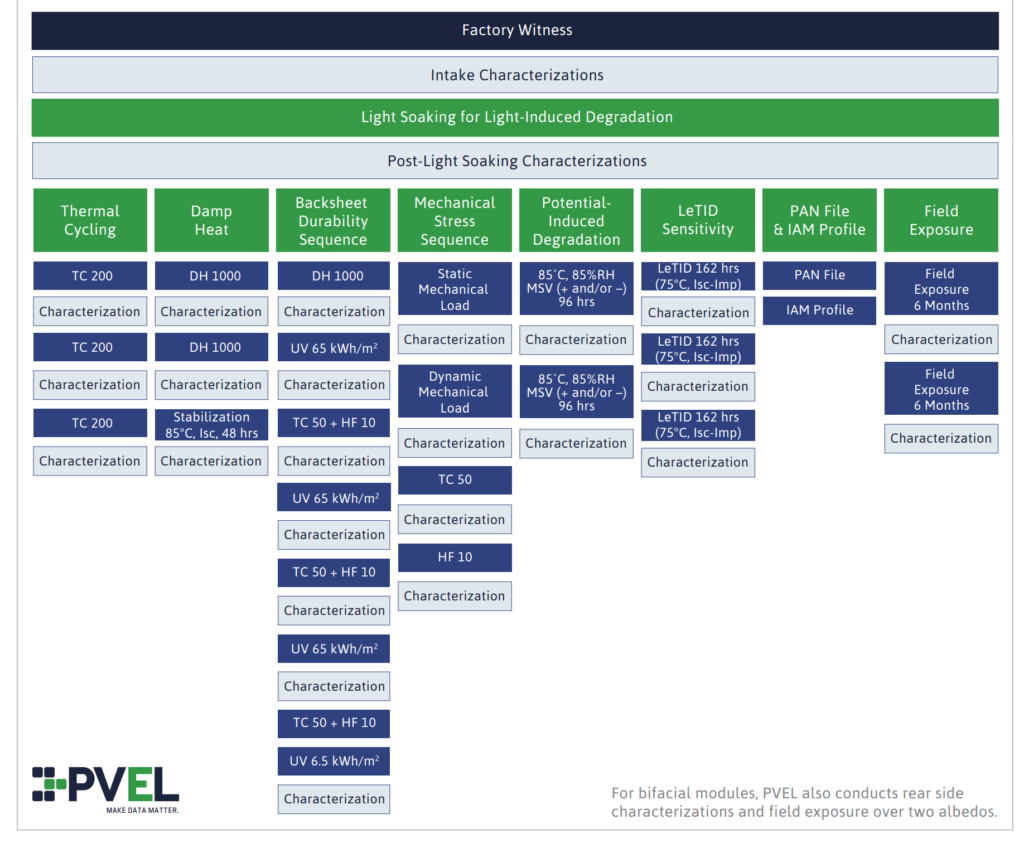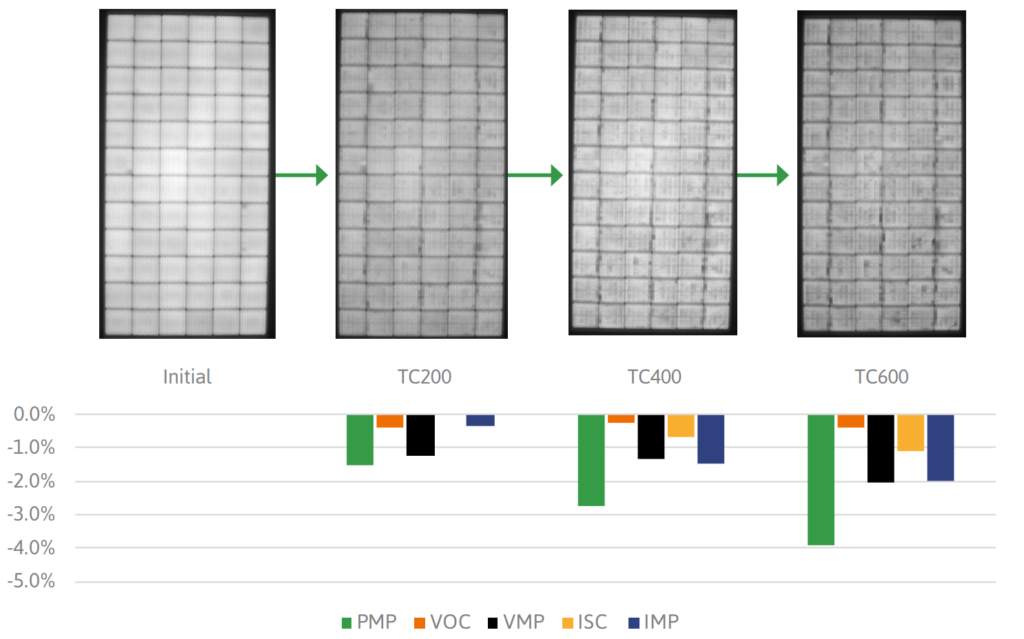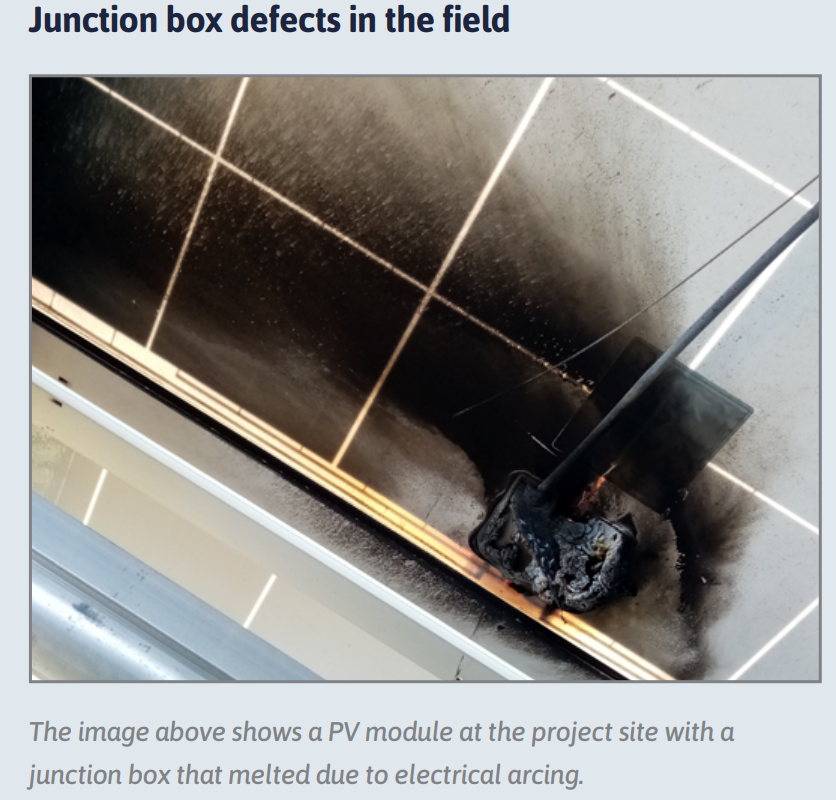The primary purpose of this post is to create a list of high quality solar panel manufacturers for consumers to further research. There are other just as high quality manufacturers that aren’t on this list (LG for instance), but if this is all you had – you’d do all right.
The secondary purpose of this post is to show some of the testing and the failures that occur. These are tests that represent what large buyers of modules care about. That’s the reason PV Evolution Labs (PVEL), in conjunction with DNV GL, does the tests. And the failures, well, that’s what happens.
First, the list of solar module manufacturers who had a unit in the PVEL test that were rated as overall “Top Performers”:
- Jinko Solar
- Trina Solar
- Hanwha Q Cells
- JA Solar
- REC Group
- GCL
- LONGi Solar
- Suntech
- Adani/Mundra
- Astronergy
- Seraphim
- Silfab
- SunPower
- Vikram
- ZNShine
- Boviet
- First Solar
- HT-SAAE
- Panasonic
- Canadian Solar
- Heliene
- Sunergy
First point that should be noted: solar panels have a very low rate of failure. Prior analysis suggests fewer than 0.2% of solar panels cause repair issues.
However, all manufacturers make mistakes. This report specifically points out that the ‘same” solar panel made by the same manufacturer – but at a different factory made up of a different bill of materials – can perform differently.
Two factories produced a near-identical bill of material. One bill of material was a Top Performer while the other degraded nearly 2x the Top Performer threshold.
In the report, the above list of manufacturers is attached to the actual factory the solar module came from.
To get a feeling for the scope of testing in this report, here’s a chart of the processes and tests that led to the creation of this list:
The very top of the chart notes, ‘factory witness’. Literally, PVEL will send people to the factory where the modules are being manufactured to see the exact components used in the module, and then cross reference them to the bill of materials supplied. It’s easy to save a few pennies by using substandard components, and those who are spending a $1 billion on a solar project will pay for the additional oversight.
PVEL defines failure in two manners – major manufacturing defects are present, leading to premature failure in the field or modules that underperform in the field and ultimately result in financial losses for the asset owner.
Thermal Cycling
Over the expected 25+ year lifetime of a solar power plant, the material components of PV modules will expand and contract thousands of times, even in moderate climates. For this test, modules are subjected to extreme temperature swings – temperature is chilled to -40°C, dwelled, then heated to 85°C, and chilled again. The cycling is repeated 200 times over three periods to a total of 600 cycles, equating to about 84 days in the climate chamber.
As the test goes from a fresh module to a module cycled 600 times, you can actually see the aging occur. In the chart, degradation increases over that period as well. PVEL notes that 2% or less denotes a ‘Top Performer’ – meaning three of five made it through this test. The median for all modules tested was 0.67% though, meaning that the large majority performed well.
Junction Box failure
The junction box is attached to the back of the solar module. It is where the wires collecting the electricity from the solar cells exit the solar panels, and then connects to other panels in strings. The types of issues seen in the junction box include bypass diode failures following thermal cycling, and wet leakage failures originating at the junction box before testing, and after thermal cycling, PID and the DML sequence.
PVEL noted that a utility scale project in South Africa, with greater than 100,000 modules installed, began to exhibit high rates of serious failures from poor soldering and failed diodes after just five years of operation. Over 3,000 modules – ~3% – were affected and had catastrophic junction box failures due to electrical arcing.
In one case, the molten plastic from the melted junction box started a brush fire in the dried grasses below the modules.
Backsheets
Your backsheet is mostly hidden from view, but its ability to seal the solar panel and protect it from the environment is a fundamental responsibility. When the backsheet seal fails, and moisture enters the module multiple events can occur.
- Ground faults: Water creates a path to ground, and these high leakage currents can cause inverters to shut down. Inverters may also experience delayed startup in sites with morning dew.
- Delamination: As moisture accumulates in a PV module, the layers of the module can separate and the electrical components can corrode.
- Safety concerns: When moisture enters delaminated, degraded PV modules, thermal events such as arc faults are more likely to occur.
The pictures above are from a 17 MW project in the Southwest U.S. ONE HUNDRED PERCENT of the backsheets in this project are cracked. The severe scorching in the backsheet above was caused by electrical arcing at the backsheet cracks that intercept the frame. The thermal event shattered the front-side glass.
In the report, other tests are outlined, and other failure methods analyzed. If you’re a buyer of solar modules, you can solicit PVEL for the test results of any specific product for free.
CommercialSolarGuy is a licensed and insured Massachusetts construction firm. Our electricians and engineers are experienced with many of these projects products. If you’re interested in a quote, please contact us at 508-499-9786 or fill out the below form:





